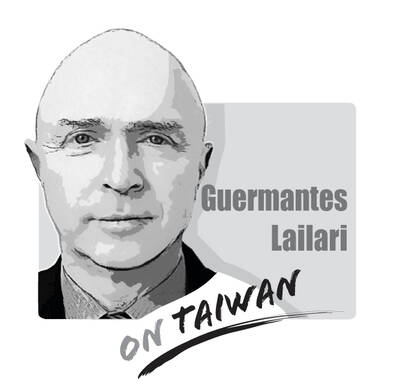China spent about US$15 billion on naval exercises last year as part of efforts aimed at gaining control of waters west of the first island chain, Reuters reported on Tuesday.
The report cited research by Taiwan’s military that was conducted “to gauge what Taipei perceives as a gap between Beijing’s intentions and its capabilities,” Reuters said.
The research showed that China’s spending on the exercises was 7 percent of its overall military budget, which has reached 1.6 trillion yuan (US$225.6 billion) this year — compared with Taiwan’s defense budget for the year of NT$606.8 billion (US$19 billion).
This gap might make the prospect of defending Taiwan seem daunting, but the nation’s focus is on asymmetrical defense capabilities, which are far less costly than the type of outward power projection that China’s People’s Liberation Army is attempting.
China is spending a lot on its military because it wants to have a blue-water navy — one which is capable of operating globally — which reports have suggested it would become after its third aircraft carrier, the Fujian, enters service.
While China is pouring vast amounts of money into its blue-water ambitions, it has not meaningfully become more capable of an invasion of Taiwan.
Responding to a report suggesting China might use its three carriers to surround Taiwan and enforce a blockade, Institute for National Defense and Security Research fellow Su Tzu-yun (蘇紫雲) on Aug. 19 said a carrier stationed off eastern Taiwan during such a blockade or conflict would find itself isolated.
The US and Japan would effectively cut off passage through the Bashi Channel and Miyako Strait, making it impossible for China to resupply the carrier, which would run out of supplies within two or three weeks. Meanwhile, Taiwan could defend itself against would-be invaders with anti-ship and anti-aircraft missiles, as well as domestically built submarines.
Of course, that is not to say that Taiwan does not have its work cut out for itself.
China could attempt to impose a quarantine — a law enforcement operation to control Taiwan’s maritime and air traffic while continuing to allow the import and export of food and medicines — which would fall below the threshold of war in international law and therefore would be difficult for the US to respond to, a report by the Center for Strategic and International Studies think tank said.
Separately, the outcome of a tabletop exercise by the Foundation for Defense of Democracies held earlier this month found that China might employ an “anaconda strategy” — using cyberwarfare and disinformation campaigns, followed by a blockade or other measures to strangulate Taiwan, rather than attempting a full invasion.
A large-scale cyberattack would be far costlier to defend against than to launch, thereby giving China an advantage, a Fox News report on the tabletop exercise said.
However, taken together, these findings suggest that Taiwan need not necessarily be concerned about China’s naval spending, which involves ambitions beyond Taiwan that are several years from fruition.
Instead, the government should accelerate investments in domestically built submarines, mobile missile launchers and medium and long-range missiles.
It should also invest heavily in cyberdefenses and reform military training to make it more productive and boost morale among military personnel.
Finally, the government must stockpile resources such as fuel and other imports it depends on. It should also diversify and decentralize its energy production.
China remains far from capable of successfully invading Taiwan despite its high military spending, but the nation must strengthen its resilience against principal threats like quarantines, blockades, disinformation campaigns and cyberattacks.

Chinese state-owned companies COSCO Shipping Corporation and China Merchants have a 30 percent stake in Kaohsiung Port’s Kao Ming Container Terminal (Terminal No. 6) and COSCO leases Berths 65 and 66. It is extremely dangerous to allow Chinese companies or state-owned companies to operate critical infrastructure. Deterrence theorists are familiar with the concepts of deterrence “by punishment” and “by denial.” Deterrence by punishment threatens an aggressor with prohibitive costs (like retaliation or sanctions) that outweigh the benefits of their action, while deterrence by denial aims to make an attack so difficult that it becomes pointless. Elbridge Colby, currently serving as the Under
The Ministry of the Interior on Thursday last week said it ordered Internet service providers to block access to Chinese social media platform Xiaohongshu (小紅書, also known as RedNote in English) for a year, citing security risks and more than 1,700 alleged fraud cases on the platform since last year. The order took effect immediately, abruptly affecting more than 3 million users in Taiwan, and sparked discussions among politicians, online influencers and the public. The platform is often described as China’s version of Instagram or Pinterest, combining visual social media with e-commerce, and its users are predominantly young urban women,
Japanese Prime Minister Sanae Takaichi lit a fuse the moment she declared that trouble for Taiwan means trouble for Japan. Beijing roared, Tokyo braced and like a plot twist nobody expected that early in the story, US President Donald Trump suddenly picked up the phone to talk to her. For a man who normally prefers to keep Asia guessing, the move itself was striking. What followed was even more intriguing. No one outside the room knows the exact phrasing, the tone or the diplomatic eyebrow raises exchanged, but the broad takeaway circulating among people familiar with the call was this: Trump did
Alarm bells over a “hollowing out” of Taiwan’s semiconductor industry and US demands for “protection money” have fueled a panic over Taiwan. To understand how misplaced these fears are, consider the movements of global technology giants. Nvidia Corp CEO Jensen Huang (黃仁勳), Advanced Micro Devices Inc (AMD) CEO Lisa Su (蘇姿丰) and Taiwan Semiconductor Manufacturing Co (TSMC) chairman C.C. Wei (魏哲家) could undoubtedly understand the situation best, and they continue to make key investments in Taiwan. They do not make decisions on a whim. They are the architects of global computing power strategy and possess the highest levels of industry knowledge. No